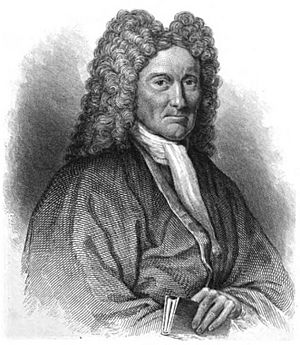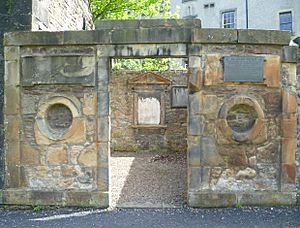Robert Sibbald facts for kids
Quick facts for kids
Robert Sibbald
|
|
|---|---|

Sir Robert Sibbald.
|
|
| Born | 15 April 1641 Edinburgh, Scotland
|
| Died | August 1722 (aged 81) |
| Education | High School, Edinburgh Edinburgh University |
| Known for | President and founder of Royal College of Physicians of Edinburgh, Founder of Royal Botanic Garden Edinburgh First Professor of Medicine at Edinburgh University |
| Medical career | |
| Profession | physician, antiquary, geographer |
| Institutions | President, Royal College of Physicians of Edinburgh (1684), Edinburgh Professor of Medicine, Edinburgh University (1685) |
| Sub-specialties | botanic medicine |
| Research | botany, medicine |
Sir Robert Sibbald (born April 15, 1641 – died August 1722) was a Scottish doctor and a historian who loved studying old things. He helped start important places in Edinburgh, like a famous garden and a college for doctors. He was also the first professor of medicine at Edinburgh University.
Contents
Life of Robert Sibbald
Robert Sibbald was born in Edinburgh, Scotland. He went to the Royal High School and studied at several universities. These included the University of Edinburgh, the University of Leiden in the Netherlands, and the University of Paris in France.
He earned his doctor's degree in 1662 from the University of Angers. Soon after, he began working as a doctor in Edinburgh.
Starting the Botanic Garden
In 1667, Robert Sibbald teamed up with Sir Andrew Balfour. Together, they started the first botanical garden in Edinburgh. A botanical garden is a special place where different types of plants are grown for scientific study and public display.
Founding the Royal College of Physicians
Sibbald also played a big part in creating the Royal College of Physicians of Edinburgh. This is a group for doctors that helps set high standards for medical care. He was chosen as its president in 1684. Both Sibbald and Balfour helped create the Edinburgh Pharmacopoeia, which was a book of rules for making medicines.
Royal Appointments and Research
In 1682, Sibbald was knighted, which means he was given the title "Sir." He was also named the King's Physician, meaning he was a doctor to the king. In the same year, he became the Geographer Royal. This role meant he was responsible for mapping and describing Scotland.
He started collecting information for a huge project: a two-volume book about Scotland's geography. He asked local ministers and nobles to help him gather details about different areas. Even though the book was never fully published, many of his notes about Scotland's geography, nature, and old artifacts still exist today.
In 1685, he became the very first professor of medicine at the University of Edinburgh.
His Writings and Legacy
Robert Sibbald wrote many books and papers. His writings covered history, old artifacts, plants, and medicine. He often used the maps and studies of another cartographer, Timothy Pont, for his own work.
He is buried in Greyfriars Kirkyard in Edinburgh. His tomb is against the southern wall of the churchyard.
A small flowering plant called Sibbaldia procumbens was named after him in 1753 by the famous scientist Carl Linnaeus. Sibbald had described and drawn this plant in his own book, Scotia illustrata, in 1684. The plant is part of a larger group, or genus, called Sibbaldia, which has about 13 different species. Another group of plants, Sibbaldianthe, was also named in his honor in 1941.
Blue Whale and Sibbaldus
Robert Sibbald is also remembered for his studies of whales. He was the first person to describe the blue whale scientifically. Because of his important work, the blue whale was originally named after him.
For a while, the blue whale was often called Sibbald's rorqual. Some scientists even placed the blue whale in its own special group, or genus, called Sibbaldus. However, today, the blue whale is usually placed in the genus Balaenoptera along with seven other whale species. The name Sibbaldus is not widely used anymore.
His Published Works
Sir Robert Sibbald wrote many books and papers during his life. These works covered a wide range of topics, including Scottish history, geography, and medicine. Some of his notable publications include:
- Scotia illustrata (1684)
- A History Ancient and Modern of the Sheriffdoms of Fife and Kinross (1710)
- Description of the Isles of Orkney and Shetland (1711)


